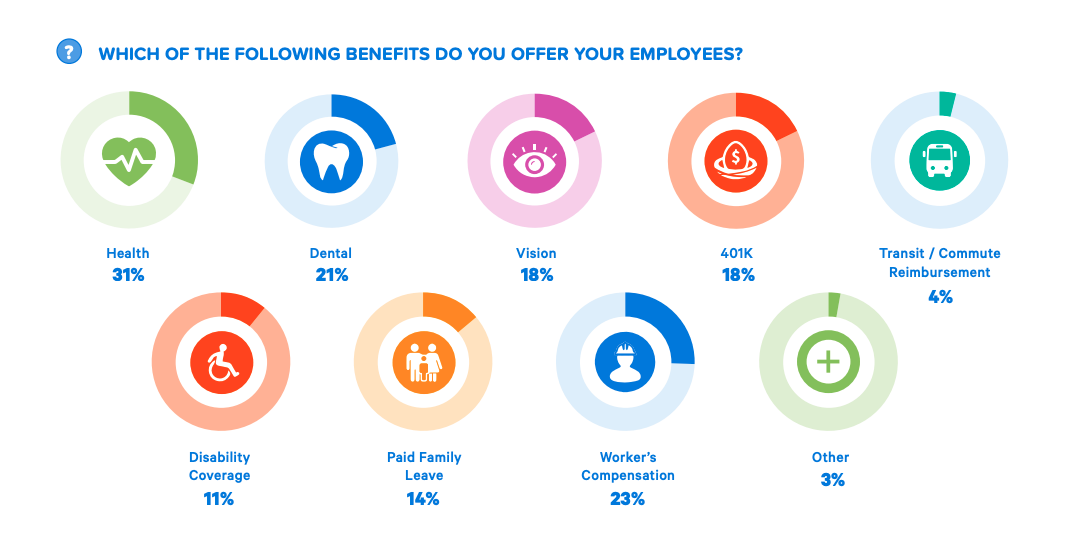
How to Create an Employee Benefits Program
Benefits make your team happy and help your bottom line.

Tyler CumellaAuthor

The average tenure of a restaurant employee in 2018 was one month and 26 days. According to the National Restaurant Association, turnover rates are the highest we’ve seen since the Great Recession, rising to 75% this year after a low of 57% in 2010.
So why the revolving door? And why is it getting worse? Long days, late nights, big demands, and few rewards.
With restaurant staff coming in and out of industry jobs, restaurant owners and managers are left constantly spending time, energy, and budget on recruiting and hiring. How are we supposed to attract new talent and hold on to the staff we already have? An employee benefits program can help.
The restaurant industry still has some of the highest rates of underinsured and uninsured workers, resulting in the financial insecurity that many restaurant workers feel. It’s not uncommon to see great workers leave the industry for a more stable paycheck and benefits, so if restaurateurs want to create a workplace where their employees feel they can have a long-term career, benefits can be pretty darn impactful.
According to Toast’s 2019 Restaurant Success Report, 31% of restaurateurs provide health insurance to their staff. But they’re also experimenting with other benefits. Here’s what the industry is offering right now.

The retention power of providing health benefits is undeniable, and there are ways to make it work (which we’ll cover below). But the good news is that, in today’s job market, restaurant employees are also interested in non-traditional workplace benefits like professional development opportunities, health and wellness, and transportation stipends.
A little creative thinking can go a long way in helping you decrease your annual employee turnover rate and get staff to stick around.
Employee Feedback Template
Use this customizable Word doc to guide self, peer, and manager reviews with your employees.

Why Offer Employee Benefits?
Creating an appealing restaurant employee benefits package is beneficial to both your team and your bottom line.
Showing your staff you care about their personal wellbeing and professional success is a proven recruitment and retention strategy. Employees want to feel valued. They want to know their employer has their best interests — both short-term and long-term — at heart.
There isn’t a one-size-fits all formula for attracting and retaining quality restaurant workers. That’d be too easy. And we’re not in this industry because it’s easy, right? But restaurant owners and managers do have the flexibility to offer benefits and incentives that align with their restaurant’s values and are sensible from an operational and financial standpoint.
Whether you’re thinking of sticking to traditional HR offerings — things like health benefits or a matched 401k — or you’re considering less conventional options, remember this: The specifics of how you build your benefits package matter less than building a supportive workplace culture that values employees’ personal and professional wellbeing and growth.
Your restaurant and its values might be firmly rooted in ideas of supporting and taking care of employees. But you’ve gotta walk the walk, too. In this guide, you’ll learn about appealing benefits and perks you can offer to employees, how you can implement them in your restaurant, and how everyone benefits.
Health Insurance Benefits
When it comes to employee benefits, health insurance is something that’s always in the back of restaurant workers’ minds, but it’s rarely discussed. And even if employees do bring up the idea of introducing health benefits, more often than not it’s just not financially feasible for owners.
In a survey of restaurant workers conducted by Restaurant Opportunities Centers United, 90% of respondents said their employers didn’t offer health coverage. Similarly, the Agency for Healthcare Research and Quality found that small businesses in low-wage, high-turnover industries, like the restaurant and food service industries, were less likely to offer health insurance.
There are currently no federal or state laws mandating that small businesses in the restaurant industry provide health-related benefits, but the Affordable Care Act requires that all businesses with more than 50 employees offer some sort of health insurance plan.
While there are no laws requiring smaller businesses to do so, it doesn’t mean restaurant staff are willing to work for restaurants that don’t offer some form of health coverage or reimbursement, especially if the job is their primary source of income. What’s to stop them from leaving to go and work for a larger restaurant?
With this massive question looming, restaurant owners and managers are left with this puzzle to solve: If an employee is unlikely to stick around for more than a few months, and insurance waiting periods can be as long as 90 days, is investing in providing employees with health benefits worth it?
Some restaurant owners and managers say no, justifying the decision to forego health insurance on a lack of regulatory requirements, a poor economic climate, or poor restaurant profit margins.
Other restaurant owners and managers say otherwise. Andrea Borgen, owner of Barcito, in LA, provides health insurance to all full-time employees. Speaking to the benefits of offering health insurance and benefits in general, she told us this:
The turnover you see at a place that offers more benefits versus one that offers basically nothing aside from what you can try and smash into your pocket by the end of the night is really significant. This is one of the tightest labor markets we’ve ever seen, at least in the span of my career, and trying to attract and keep talent is really challenging. So you need to stack your deck with everything you can in order to be appealing and stand out.
Andrea Borgen
Owner, Barcito
Doug Marschke, owner of Underdog Restaurants, in CA, also offers employee benefits like health insurance and believes they can actually help you save money in the long run. He says, “Hiring and training a new person takes a lot of effort. It’s a big time and financial investment. It takes time to train new people, but it also takes time for new people to become good at their jobs. The first thirty days are a whirlwind, and they may not really be up to par with the rest of the staff until sixty days in. This is all a huge investment. If you have to keep doing this over and over again, you’re losing thousands of dollars. That’s why we spend the money upfront on benefits like health insurance to help us retain employees.”
But these restaurateurs’ experiences don’t help answer the question of cost. To make the numbers work at the outset and lower the hit on profitability, some restaurateurs add a surcharge to guest bills and increase menu prices. These are both done transparently, communicating the reason behind the increase to guests either in a note on the menu or directly through servers and management. Guests might not be too happy about the price increase starting out, but hearing how it’ll benefit their favorite server or bartender will help offset that.
To help answer the question of turnover and retention, many restaurateurs bake health benefits into a long-term employee incentive program. This means employees only become eligible after being with the business for an extended period of time, say six months to a year.
If you’re interested in providing your restaurant staff with health insurance but don’t know which HMO to choose, consider using a platform like Health Care HQ or Stride Health. Both provide users with a comprehensive suite of health care insurance programs they can select from, making the process of choosing a health care provider much more personal.
Speak to other restaurateurs in your area, too. What do they think about offering health benefits? If they do offer health insurance or reimbursement, ask them how they go about it. How do they make it work without breaking the bank?
For more information on how real restaurants approach offering benefits like health insurance, read our article that features how real restaurants find room in the budget for employee benefits.
Employee Profit Sharing
A benefit that’s newer to the restaurant scene is employee profit sharing. Profit sharing is an incentive-based system where staff receive payment — in addition to their regular compensation and bonuses — depending on the restaurant’s profitability. So if the restaurant has a really strong quarter, your employees receive a proportional cut.
That’s a great employee benefit — who doesn’t enjoy a little extra cash in their pocket? But it also has a positive impact on the restaurant. The idea is that because employees know they play a role in the restaurant’s success every time they work a shift, profit sharing leads to a more unified staff.
Juliet Restaurant, in Somerville, MA, is one such restaurant that does employee profit sharing and has seen the positive impact it can have. Co-owner Josh Lewin shared with us this:
Everybody’s incentivized by the success of the restaurant because they play a direct role in it. The incentive in a traditional service environment is to sell as much as possible to each individual person because it’s literally your own money. What we're looking for is a more comprehensive view of what success looks like, what revenue growth looks like over time, and how our team can share the wealth.
Josh Lewin
Co-owner, Juliet Restaurant
If you want to give profit sharing a shot, start by testing it out with manager-level employees. Get a feel for the system, work out any kinks, see how these employees respond, and try to understand how it might affect your bottom line. If you see a positive impact and things go well, start to expand it to all employees.
Cash Bonuses
You know what they say: Cash is king. If you’d like to offer good ol’ fashioned cash incentives to your employees as benefits, there are a few ways to stretch your dollars.
You can use cash bonuses as a motivation tool. Offer cash rewards to staff who consistently show up on time or have few-to-no sick days. It can motivate employees who are less punctual or prone to habitually calling in sick on weekends.
Another idea is to surprise employees and gift cash bonuses “just because.” Reward great customer service or give a cash bonus as a token of appreciation for an employee who always stays late to help fellow servers who are in the weeds.
Paid Time Off
Outside of the restaurant industry, paid time off is a base-level benefit people have come to expect. But that’s not to say restaurant workers aren’t looking for it.
A paid time off (also known as PTO) policy combines vacation, sick time, and personal time into a lump sum of days for your employees to use when they want or need to take paid time off from work. Some policies start with a base number of paid days off, with workers then having the ability to accrue more days off based on how long they’ve been with the business.
If you decide to create a PTO policy for your restaurant, instate a rule where employees must request this time off in advance. Unless it’s a sudden sickness or an emergency comes up. Employees can’t be taking vacations out of the blue. You could also require that an employee work at your restaurant for a certain period of time before they can tap into paid days off.
A PTO policy has immediate, obvious benefits to restaurant employees. But it’s also a strong hiring and retention tool. A paid time off policy, however you decide to structure it, will make your restaurant more of an appealing business to work for.
And a less immediately recognizable benefit to a PTO policy? It gives you greater control over unscheduled and out-of-the-blue callouts. Employees will be less likely to call out day-of if they can schedule time off and figure out shift coverage in advance.
Professional Development
One of the most common reasons young, high-performing employees leave a job is due to a lack of professional growth opportunities. No one wants to feel stuck in a job that won’t advance their career.
The restaurant industry is particularly guilty of not providing employees with opportunities to grow their professional skill set and advance to new levels in their respective careers.
But the restaurant doesn’t have to be a dead end gig. Challenge the public perception and create a dedicated professional development fund. Not only will this give you a more skilled workforce, you’ll give employees another reason to choose you over the competition.
Set up a profile for each of your employees on an online learning platform like Skillshare and LinkedIn Learning — both are treasure troves of creative and business skills. There are also plenty of restaurant-specific training and professional development tools and learning platforms. One option is Typsy, which offers online hospitality training. Learn more about the different employee training options available to you in our how-to guide.
Free Meals
Restaurant employees are often asked to work through meal times, preparing and serving food they rarely get the opportunity to enjoy. Or, on the other end of the spectrum, your restaurant staff have eaten so much of your restaurant’s food they need a new incentive.
Offering a free meal — whether it’s a shift meal or a gift certificate staff can use at the restaurant as they please — is an easy way to say thanks for putting in a hard day’s work. Some restaurants even have a special menu of free items for staff to order from when they get a break during meal service. Some restaurants also hold weekly staff meals, as a way to get the team together in an informal setting, eat and enjoy each other’s company.
Free meals are also an effective way for your staff to learn the menu and be able to make educated recommendations to your guests. Your staff members definitely wear many hats, and sales rep is one of them. Wouldn’t it be better if your servers could genuinely tell a guest what their favorite dish is and why they love it?
Also consider the amount of unused restaurant food that winds up wasted and in the trash. Providing your team with free meals is both an employee benefit and waste management strategy.
Transportation Stipends
Depending on where your restaurant’s located, the only thing harder than finding parking is finding free parking... if your staff member even has a car. Then there’s the rising costs of gas.
If they don’t have a car, other means of transportation like the subway or buses can get pricey, all depending on where your restaurant’s located and where your team members live.
Maintaining your lifestyle can be difficult when you live off of a tipped or low income wage, and transportation costs can put a sizable dent in your employees’ budgets. Consider factoring in employee stipends and benefits when you're calculating your restaurant's payroll.
You can help employees by subsidizing the cost of a public transportation pass or a parking garage. You can also introduce a wellness program to incentivize employees to consider using alternative, more eco-friendly modes of transportation like biking.
Contributions to Childcare Costs
Childcare is unaffordable for the majority of families in America. According to a 2018 study by Care.com, the average American family will spend 20% of their yearly income on childcare costs. And the restaurant industry is its own beast.
There are more than one million single mothers working in restaurants around America, and some 40% of those live at or below the poverty line. These mothers spend an average of 35% of their weekly wages on childcare.
Contributing to your employees’ child care costs helps alleviate a heavy financial burden and may lead to improved employee morale and availability. You’ll also be less likely to have parents call out when their child is home with a cold or if something else should come up, since they’ll be more likely to afford the help.
Rewards for Employee Loyalty
If you want to encourage your staff to stay with your restaurant long-term, show them what their loyalty means to you.
When a staff member reaches their employment “birthday” or work anniversary, throw a party or dinner for them to celebrate the milestone. Give them extra vacation time, a gift card, or a floating personal day to be taken on a day of their choosing.
Keep track of your employees’ start dates so you know when to reward and celebrate them. If you eventually decide you want to offer health benefits to your team, you’ll likely already be doing this, since you’ll need to keep track of when to enroll employees after they’ve been with the business for a certain amount of time.
One-on-One Meeting Template
Make weekly, biweekly, or monthly check-ins with employees productive with this customizable Word doc for your one-on-one meeting agendas.

Team-Building Activities
The average person spends 90,000 hours working in their lifetime. Anyone who’s ever worked will tell you it’s their coworkers who help make those hours as enjoyable as possible.
Creating opportunities for your staff to hang up their hats for an evening and spend some quality, off-the-clock time together is an excellent and effective way to strengthen a sense of kinship and community.
These activities can be informal — like a team meal to sample new menu items — or a recurring monthly event. You could go rock climbing or bowling, do a paint night, or go out to a movie. Whatever you think your team will enjoy doing. Or, you don’t have to guess at all. Ask your employees what they’d be interested in doing together as a team.
Related Restaurant Resources
Mental Health and Wellness Benefits
Shift drinks and staff meals are benefits that people who’ve worked in the restaurant industry for any amount of time have come to expect. But there are a growing number of benefits out there focused on improving employee wellness and mental health.
It’s no secret that the restaurant industry is plagued by struggles with alcohol and substance abuse. According to a 2015 study by the Substance Abuse and Mental Health Services Administration, the food service and hospitality industry has the highest rates of substance abuse and third-highest rate of alcohol use of all industries. Meanwhile, a 2018 study by the American Journal of Epidemiology reported that service workers who rely on tips are at greater risk for depression, sleep problems, and stress as compared to those in non-tipped, salaried industries.
To help combat this industry-wide struggle, introduce programs and activities as part of your employee benefits package that promote a healthier lifestyle for your restaurant staff. Here are a few ways you can help out your employees:
- Provide resources leading to outside support systems, including national organizations like Chefs with Issues and Ben’s Friends.
- Offer discounted access to yoga classes, gym memberships, or fitness classes.
- Advocate for healthier, balanced food and drink habits. Consider cutting shift drinks.
- Promote and provide discounted or fully covered access to apps and online resources for yoga and meditation. Headspace and Calm are both great options.
Health and wellness benefits like these aren’t super common right now, but we live in a time where the national dialogue around wellness and mental illness is becoming more open and candid. Your employees will appreciate it. Plus, it can have a positive impact on turnover and retention.
Kat Kinsman, senior editor of Food & Wine, shared this with us:
Workers will stay at a restaurant they know supports and values them beyond just being a set of hands in the kitchen, or a face in the dining room. Take care of your people, and they'll stick around and be the best possible ambassadors for your establishment.
Kat Kinsman
Senior Editor, Food & Wine
We couldn’t have put it better ourselves.
To learn more about restaurant staffing and retention, check out Toast Video Courses.
Related Resources
Is this article helpful?
DISCLAIMER: This information is provided for general informational purposes only, and publication does not constitute an endorsement. Toast does not warrant the accuracy or completeness of any information, text, graphics, links, or other items contained within this content. Toast does not guarantee you will achieve any specific results if you follow any advice herein. It may be advisable for you to consult with a professional such as a lawyer, accountant, or business advisor for advice specific to your situation.
Read More
Subscribe to On the Line
Sign up to get industry intel, advice, tools, and honest takes from real people tackling their restaurants’ greatest challenges.


